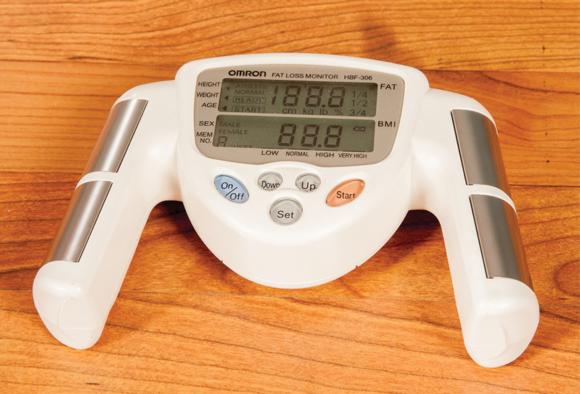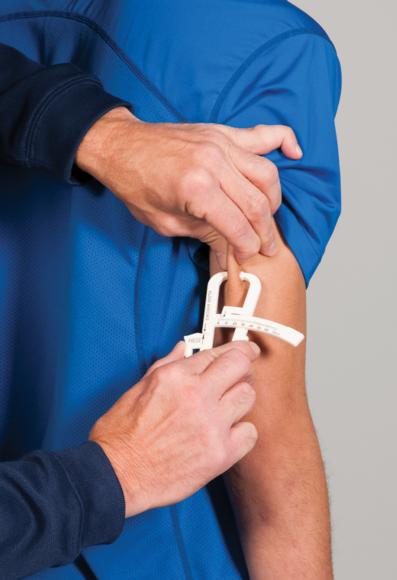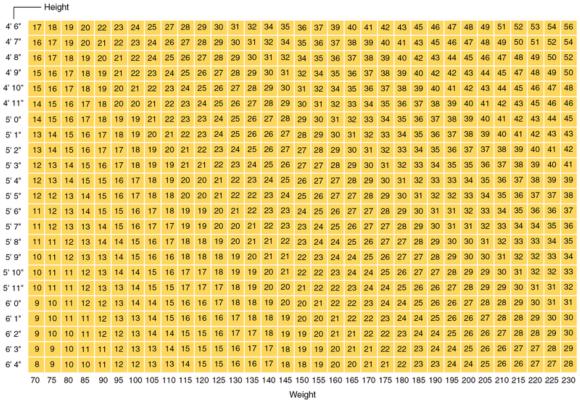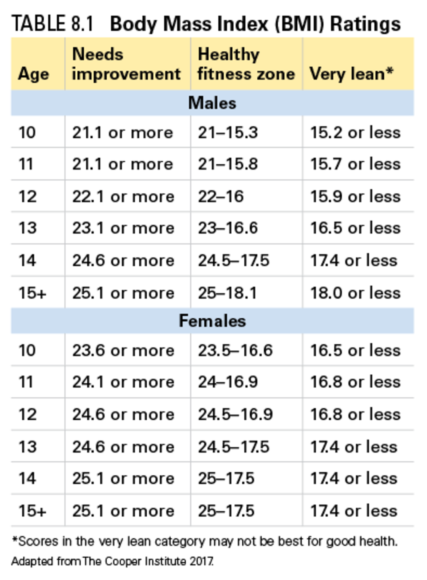How Can I Assess My Body Composition?
This is an excerpt from Fitness for Life Middle School 2nd Edition With Web Resource by Charles B Corbin,Guy C Le Masurier,Dolly D Lambdin.
Body fat is one important component of body composition. Ideally, people shouldn't have too much or too little body fat. The goal is to be in the healthy fitness zone for your level of body fat. The best methods of assessing a person's body fat level involve the use of X-ray machines and special water measurement tanks. These tests are expensive and can't be used quickly, so they aren't practical for general school classes. There are several methods of assessment that are commonly used in schools.
Some schools use a bioelectrical impedance analysis (BIA) machine to assess body fat levels (figure 8.3). Bioelectrical impedance machines have been shown to be quite accurate when used properly. The machine detects differences in water, lean body tissue, and fat, allowing it to estimate the amount of body fat that a person has. Schools that do not have BIA machines can use two other inexpensive methods: body mass index and skinfold measurements.

Figure 8.3 BIA machines can be used to assess body fat levels.
The most common body composition measurement used in schools is called the body mass index (BMI). As described in a special feature later in this lesson, you use your height and weight in a formula to calculate your BMI. The BMI doesn't directly assess body fat levels, but it does help you determine if you are in the healthy fitness zone. The BMI is a test commonly used in FitnessGram.
The BMI uses a formula to determine if you're overweight. The term overweight simply refers to having a BMI (combination of height and weight) that is higher than recommended for good health. Being overweight isn't the same as being high in body fat. It's possible to be high in weight without being too fat, because muscle weighs more than fat. People with a lot of muscle weigh more than people of the same size with less muscle. Even though there are limitations to the BMI, scientists indicate that people with a high BMI have more risk for heart disease, diabetes, and other chronic diseases than people with a BMI in the healthy fitness zone. A person who has an exceptionally high BMI without an exceptionally high amount of muscle or who has an exceptionally high amount of body fat is considered to be obese.
Fit Fact
Overweight in America
Two-thirds of adults and one-third of children and teens are considered to be either overweight or obese, resulting in increased chronic disease risk for many Americans.
Another method of assessing body composition is called skinfold measurements (figure 8.4). As shown in the photo, fat located under the skin is measured using a pair of skinfold calipers. The calipers are used to measure the thickness of fat folds beneath the skin. This test estimates the amount of fat in the body. Skinfold measurements are not as accurate as X-rays and underwater weighing, but they are often used because they give a good estimate of body fat levels and require only a relatively inexpensive pair of calipers and a trained person such as a teacher.

Figure 8.4 Calipers are used to make skinfold measurements.
The results of either the BMI or skinfold measurement tests will help you determine if you are in the healthy fitness zone. Your test results will show if you're in a zone that helps you function effectively and avoid problems associated with having too much or too little body fat or body weight.
Information about your body weight and body composition is personal. In fact, you have the right to treat all fitness testing results as private information. If people ask about your body weight, body composition, or other private information that you're not comfortable sharing, you can make a statement such as, "I don't feel comfortable sharing my personal information. Could you please respect my desire to keep personal information private?"
You should also help others keep their personal information private. For example, don't ask other people about their body weight or body composition. Also, if you work with a partner, keep that person's information private. In chapter 4, you learned some guidelines that you can use to build self-esteem. You may want to review those guidelines at this time.
You can take other steps to keep information confidential. One of the best ways is to share it only with people you trust, and only after asking them to keep the information private. Over time, you can build caring relationships with others, and this will reduce your need to worry about privacy. Sometimes, feeling comfortable in sharing information relieves the pressure of trying to keep things private.
Body Mass Index
Follow these steps and record your results.
- Measure your height in inches or meters without shoes.
- Measure your weight in pounds or kilograms without shoes. If you're wearing street clothes (as opposed to lightweight gym clothing), subtract 2 pounds or 1 kilogram from your weight.
- Use the body mass index chart to determine your BMI. You can also calculate your BMI using either of the following formulas:
BMI = weight in kilograms/(height in meters)2
BMI = weight in pounds/(height in inches)2 × 703
- Use table 8.1 to determine your rating for BMI.
Text adapted from C.B. Corbin and G.C. Le Masurier, 2014, Fitness for life, 6th ed. (Champaign, IL: Human Kinetics), 80.


Height/Weight to BMI chart. Locate the row containing your height (left) and column containing your weight (bottom). The value in the box where rows and columns meet is your BMI.

Learn more about Fitness for Life: Middle School, Second Edition.
More Excerpts From Fitness for Life Middle School 2nd Edition With Web ResourceSHOP

Get the latest insights with regular newsletters, plus periodic product information and special insider offers.
JOIN NOW
Latest Posts
- Using double inclinometers to assess cervical flexion
- Trunk flexion manual muscle testing
- Using a goniometer to assess shoulder horizontal adduction
- Assessing shoulder flexion with manual muscle testing
- Sample mental health lesson plan of a skills-based approach
- Sample assessment worksheet for the skill of accessing valid and reliable resources


